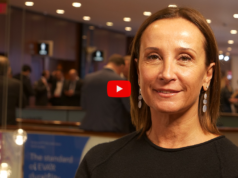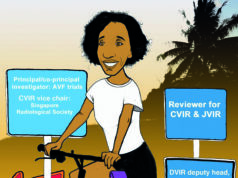“I strongly believe that you cannot be what you cannot see. If you want more women or under-represented minorities (URMs) to enter the field and be at the table, then we need more women and URM leaders in the field,” Maureen Kohi (Chapel Hill, USA).

What attracted you to a career in interventional radiology?
My ‘a-ha’ moment that drew me into a career in vascular and interventional radiology was during my third year of medical school. I had observed countless prolonged open surgeries, and then scrubbed into one of my first cases of endovascular aneurysm repair of the abdominal aorta. I was moved by the precise and delicate deployment of the stent graft by a ‘vascular and interventional radiologist’ who forestalled a major abdominal surgery and resulted in the patient experiencing a quicker post-procedure recovery, faster hospital discharge, and lower complication rates. I loved the innovation of the field, the efficiency of the procedures, the delicate and yet deliberate procedural dance, and the monumental impact on clinical care provided through a pinhole. I knew I would be destined to become a vascular and interventional radiologist.
Who have been your mentors?
I owe my entire career to my mentors and sponsors along the way, as I truly believe we stand on the shoulders of giants, and I am forever grateful for their support. My most impactful mentor was Ernie Ring, who showed me the glorious world of academic interventional radiology. At the University of California, San Francisco (UCSF), I owe my research and academic success to my research mentors Karen Ordovas and Sharmila Majumdar who taught me how to become a physician-scientist and a research mentor. I also felt so incredibly supported and promoted by my chairman, Ron Arenson, who encouraged me to pursue a leadership career in radiology. During my junior faculty years, I was very fortunate to meet several luminaries who took me under their wing and helped to mentor and sponsor my career. I am forever indebted to Anne Roberts, Barry Katzen, Dan Sze, Jafar Golzarian, Jim Benenati, Jim Spies, Laura Findeiss, Mahmood Razavi, Mike Dake, Mike Darcy, Kathy Krol, Lindsay Machan and Ziv Haskal. During my transition from division chief to department chair, I relied a great deal on support and mentorship from Alan Matsumoto, Bob Ryu, Chuck Ray, Jim Spies, John Kaufman, Matt Mauro, and Reed Omary. Throughout my career, I have been very fortunate to have tremendous women peer mentors and I do not believe I could be where I am without the love and support of Kari Nelson, Theresa Caridi, Nadine Abi-Jaoudeh, Alda Tam, Alex Barnacle, Gloria Hwang, Janice Newsome, Nishita Kothary, Isabel Newton and Tze Wah.
Has COVID-19 provoked new ways of working for the interventional radiologist long-term?
In the clinical realm, we have learned a great deal about telehealth and the ability to offer our services to remote areas. In education, we have learned to leverage virtual platforms for conferences, grand rounds, and guest speakers. However, as good as we have become at assembling virtual meetings, I feel we all crave the in-person experience of socialising and networking. While the virtual component is ‘good enough’, it does not come close to the ideal of in-person meetings. In short, COVID-19 has taught us how to pivot, be nimble, and evolve, but some things are best left in the ‘old world’ such as meeting in-person, without social distancing, and masks. I really hope we can get back to that ‘old normal’ real soon!

Could you share a positive and negative experience you have had as a woman leader, and how you dealt with both?
As a female leader, I find any interaction where I promote or recruit a woman into the field of radiology or interventional radiology or within its leadership as a positive experience. Most recently, my most positive experience was my privilege to name Gloria Salazar as the very first woman Latin X division chief of Vascular Interventional Radiology at University of North Carolina and also nationwide. I have been fortunate in not having encountered many negative experiences as a female leader. However, the one that comes to mind is being repeatedly mistaken as a medical student, resident, fellow, nurse, or technologist. Once I was written up by a patient who felt I was a resident who placed her chest port when I was a first-year junior faculty. It reminds me of the eternal unconscious bias that as a young-appearing woman interventional radiologist, I look like every other member of the team, except for the attending physician or the leader of the team.
Could you describe your interventional radiology-suite personality?
I am a very efficient and fast-paced person who plans multiple steps ahead and enjoys a brisk procedural dance. I also like to set a relaxed and social procedural environment where I can teach my trainees about how I do a variety of procedures and also use the time to learn more about them. However, when the procedure gets more complicated or things are not going according to plan, I become quieter and more deliberate, knowing that as the attending, I set the cadence in the room. The calmer I am, the more relaxed the environment. The patient is always the focus of our work and the closer and more connected we are as a team, the more successful we will be at delivering excellent patient care.
What is the most exciting way of attracting women and URMs to the interventional radiology table?
I strongly believe that you cannot be what you cannot see. If you want more women or URMs to enter the field and be at the table, then we need more women and URM leaders in the field. We only have one woman interventional radiologist as department chair and currently there are no URM IRs as department chairs. There are no women or URM IRs as deans or CEOs of medical centres. However, we are seeing numerous women IRs become division chiefs and programme directors. This is the first step to bridging the gender and racial gap to ensure we have excellent role models at the table to attract the next generation of leaders, particularly women and URMs into the field.
In the last year, which new research paper has caught your attention?
One of the most interesting manuscripts was the publication of the FEMME (Fibroids with either embolisation or myomectomy to measure the effect) trial, which was a randomised controlled trial comparing quality of life associated with the two treatments among women wishing to avoid hysterectomy. The primary outcome of this trial was the change in the Uterine Fibroid Symptom and Quality of Life (UFS-QOL) questionnaire after two years. This trial was the very first of its kind to have a very diverse population with a large number of African American participants, women with large uteruses, and severe fibroid symptoms. The trial demonstrated that the myomectomy group had a longer hospital stay and almost double the complications than the uterine fibroid embolization (UFE) group. While both groups demonstrated improvement in their UFS-QOL scores after therapy, the myomectomy group demonstrated a slightly higher improvement compared to the UFE group. Overall, the trial demonstrated that UFE and myomectomy are more alike than different. In addition, it demonstrated that compared to myomectomy, UFE resulted in post-embolization syndrome, shorter hospital stay, quicker return to work, fewer severe adverse events, and potentially comparable fertility outcomes.
Could you describe a memorable case?
I was consulted about a 23-year-old female who had presented with massive vaginal bleeding due to a uterine arteriovenous fistula (AVF) following a dilation and curettage (D&C). She underwent UFE with particulate embolization, which was unsuccessful and continued to experience severe vaginal bleeding and was planned to undergo a hysterectomy. I was fortunate to have been consulted to see if there was any way to preserve her fertility. I was able to embolise the AVF by directly puncturing and embolising the nidus using ethylene vinyl alcohol copolymer. She went on to have a quick recovery and then become pregnant and give birth to a healthy baby. The case taught me that the innovative spirit of interventional radiology lives in all of us. In addition, it reminded me that we should not be so quick to recommend hysterectomy. Instead, we should take a step back and think of what else we can offer to preserve fertility and avert hysterectomy. We would never do a nephrectomy for a renal AVF or a pneumonectomy for a pulmonary arteriovenous malformation. So why remove a woman’s uterus because of a fistula? Go direct and obliterate the fistula, retain fertility, and avoid hysterectomy.
What interests you outside of medicine?
I most enjoy spending time with my 11-year-old son, husband, dog and our friends. I also love all things athletic: running, biking, hiking, kayaking, jet skiing, or going to a baseball or basketball game. I am a huge Tar Heel fan, so anything that applies to the University of North Carolina. I am inspired by music and played trombone in the Stanford band. My other interests include baking, travelling, and wine. Reading a book (anything by Jane Austen) at the beach with my feet in the water while my son and husband body surf is a favourite pastime. As I grew up in Northern California, I love wine tasting and learning about how wine is made. Moving to the South my interests have expanded into visiting breweries and distilleries and learning more about Southern cooking.










